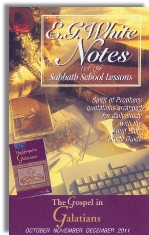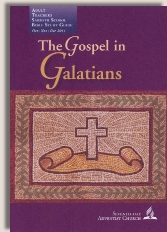|
||||||||||||||
Commentary on "The Unity of the Gospel"
Day 6: Thursday, October 13, 2011 - Paul's Concern
Overview
It is supposed that today the mystery of Paul's criticism of Peter would be resolved, even if the solution was anticipated in yesterday's lesson. Paul's argument, however, is reduced to the issue of Peter's actions sending the gentiles the message that they were, at best, second-class Christians, thus pressuring them to conform to circumcision in order to become first-class Christians. Although the lesson mentions that Peter's actions compromised the gospel, there is no explanation as to how making other people feel like second-class Christians compromises the gospel. The only possible explanation is that the gentiles would feel that they were still not fully benefiting from Jesus' work proclaimed by the gospel if they were not Jews.
Observations
This approach raises unanswered questions. If the gentiles were second-class Christians, they would still be Christians saved by Jesus, and the gospel would still have its most important effect in their lives. If only some of the peripheral benefits of the gospel would not be available to them without circumcision, this would not be a big reason for concern, because the gospel would still do its work. It would still be the true gospel.
There are evidences that the compromise of the gospel, however, goes beyond creating class differences between believers; rather, the Galatian heresy was denying the power of the gospel to save apart from embracing circumcision and the entire package of the Mosaic covenant. Unless they would accept circumcision and keep the Law, the gentiles could not be saved (Acts 15:1).
On Sunday we noted that the author thinks of the apostolic circle as being less united around the gospel than the evidence indicates. From the author's perspective, the level of agreement between the apostles and Paul is not high, and Paul has to fight in order to assure unity. His confrontation of Peter at Antioch was part of this struggle. From this point of view, the agreement reached previously by the apostles when Paul met with them was jeopardized by Peter. Thus Peter's actions threatened to divide the church, and Paul's intervention kept the church united by sustaining the previous agreement.
From the Adventist perspective what happened in the apostolic circle can be described in this way: the apostles agreed with Paul that gentile Christian churches would be free from Mosaic regulations, while the Jewish Christians would still submit to them.
This perspective, however, is only a part of the picture, because the agreement involved more than this. It involved the fact that the Jewish Christians were equally freed from the Mosaic regulations. They were as free as any gentile, if they wished to abandon their traditions. The Jewish Christians, it was understood, would be as free as the gentiles to eat kosher foods if they shared meals with gentiles, and this is what Peter did in Antioch. Peter not only agreed with the liberty given to the gentiles, but he also enjoyed their liberties, living as a gentile (Gal. 2:14). The unity in the apostolic circle did not only grant rights to a certain group of people while denying them to another group, but it granted those rights to all the members of the church, Jew or gentile, apostles included. When Peter ate non-kosher foods with gentiles at Antioch, he simply enjoyed the rights of every Christian, Jew and Gentile. He lived in harmony with the truth of the gospel.
His change of behavior didn't change his views on the gospel, but he was now inconsistent. His behavior was out of harmony with the truth of the gospel and was a practical denial of liberty in Christ, even for Peter. If such a behavior would have become generalized, not only gentiles would loose the benefits of the gospel but also the Jewish Church, Peter included, would lose them. The gospel would be reduced to nothing—not only for gentiles, but for the entire Church.
Unfortunately, the Adventist author doesn't understand that the unity of the apostolic circle was solid and based on something more than agreement, that even the Jewish apostles enjoyed the liberties of the gentiles, not being required to submit to Mosaic regulations, like food laws. He doesn't see that even apostles themselves didn't consider the practices of their Jewish churches as mandatory. Rather, those practices provided a way to be Jews when they were with other Jews' for the sake of the gospel (1 Corinthians 9:20). In the context of mission to the Jews, even Paul was willing to circumcise Timothy, because, for the sake of the gospel, every obstacle should be removed, except the scandal of the cross.
The same gospel brought liberty from the jurisdiction of the Old Covenant Mosaic Law, even for the Jews, but for the sake of their unbelieving compatriots. The Jewish community of Christians still attended the Temple, still circumcised their sons, still kept law foods and Sabbath, because these things were part of their own culture. It was agreed that any Christian Jew was free from these laws as far as salvation and participation in the blessings of the New Covenant is concerned. Even the apostles lived like gentiles when in the fellowship of gentiles, not like Jews.
The Adventist perspective sees the unity between the churches as more of a political, external agreement between two political parties, a "live and let live" truce, an armistice, an arrangement that let people be happy in two different worlds that didn't intersect, like two circles that are external to each other. In reality, it was a single circle, and even if the two communities had their own customs, people were free to migrate from one community to another, to enjoy the same liberties from the Mosaic rules. There were not two Christianities, one sticking with the Mosaic covenant rules, one rejecting it. It was one body, the body of Christ, enjoying the same liberties, no longer under the Old Covenant.
The postmodern picture of multiple Christianities that dominate the secular media, thanks to the popular works of Bart Ehrman, John Dominic Crossan, and Elaine Pagels, has its attractiveness, and the Adventist view leans this direction. These liberal views, while they are intelligent and articulate, don't go very deep in understanding how people of different backgrounds are one body in Christ, how in the middle of disparate and seemingly contradictory practices, there is a unity of mind and belief that only the gospel is able to assure.
Copyright 2011 BibleStudiesForAdventists.com. All rights reserved. Revised October 12, 2011. This website is published by Life Assurance Ministries, Glendale, Arizona, USA, the publisher of Proclamation! Magazine. Contact email: BibleStudiesForAdventists@gmail.com.
The Sabbath School Bible Study Guide and the corresponding E.G. White Notes are published by Pacific Press Publishing Association, which is owned and operated by the Seventh-day Adventist church. The current quarter's editions are pictured above.
Official Adventist Resources
Standard Edition Study Guide Week 3
Teacher's Edition Study Guide Week 3
Easy Reading Edition Study Guide Wk 3
Search the Complete Published Ellen G. White Writings
Please Support This Project


